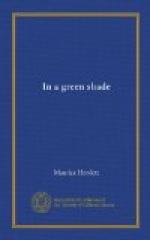My fugitive years are all wasting away,
And I must ere long be as lowly as they,
With a turf on my breast and a stone at
my head,
Ere another such grove shall arise in
its stead.
Put beside that melodious jingle the ordered diction and ordered sentiment of one of the best-known and most elegant poems in our tongue. They were written within fifteen years of each other. Within the same space of time, or near about it, there came this spontaneous utterance of simplicity, tragedy and hopeless sorrow:
Young Jamie lo’ed me weel, and sought
me for his bride;
But saving a croun he had naething else
beside:
To make the croun a pund young Jamie gaed
to sea;
And the croun and the pund they were baith
for me.
The authoress of that was born twenty-one years before Gray died. I speak, perhaps, only for myself when I say that reading that, or the like of that in Burns or in Blake, my heart becomes as water, and I feel that I would lose, if necessary, all of Milton, all of Shakespeare but a song or two, much of Dante and some of Homer, to be secured in them for ever. My friend (of the Ramillies) and I were disputing about a phrase I had applied to lyric poetry as the infallible test of its merit. I asked for “the lyric cry,” and he scorned me. I could find a better phrase with time; but the quatrain just quoted makes it unmistakable, as I think. Anyhow, it will be conceded that there was some putting off of the tie-wig, the hoop and the red-heeled shoe about 1770.
In the time of Reform, say from 1795 to 1830, you could do much as you pleased, and dress according to your fancy. You could smother your neck in a stock, wear a high-waisted swallow-tail coat, kerseymere continuations and silk stockings. So sat Southey for his portrait, and so did Rogers continually. Or you could wear a curly toupe with Tom Moore and the Prince Regent, be as rough as a dalesman with Wordsworth or as sleek as a dissenting minister with Coleridge, an open-throated pirate with Byron, or a seraph with Shelley. If the rules lingered, they were relaxed. I think there were none. Individuality was in the air; schools were closing down. For the first time since the spacious days men sang as they pleased, and some sang as they felt and were, but with this difference added that you would no longer identify the age with the utterance. There were many survivals: most of Coleridge, all of Rogers, much of Byron, some of Wordsworth (Laodamia) is eighteenth century; and then, for the first time, you could archaicize or walk in Wardour Street—Macpherson had taught us that, and Bishop Percy. But all of Shelley and Keats, the best of Coleridge and Wordsworth belong to no age.
The pale stars are gone!
For the sun, their swift shepherd,
To their folds them compelling,
In the depths of the dawn,
Hastes in meteor-eclipsing array and they
flee
Beyond his blue dwelling,
As fawns flee the leopard.
But where are ye?




